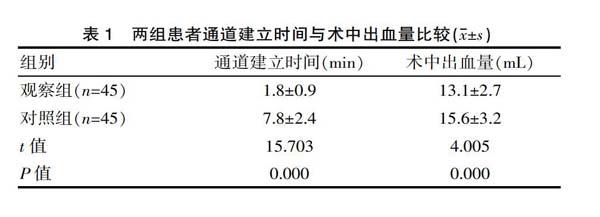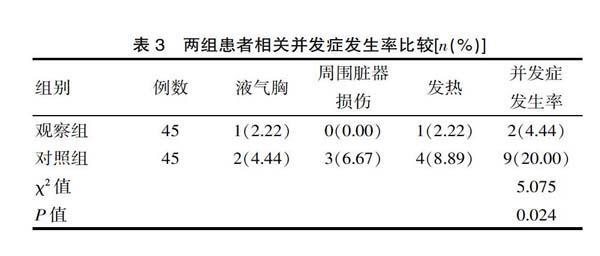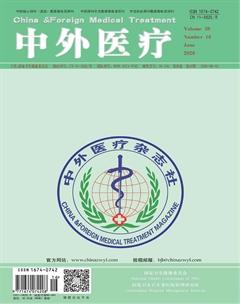B超定位一步擴張法建立經皮腎通道在腎結石患者治療中的應用研究
吳兆春 曾會勇 韓巧軍 徐漢新 陳溯 邱錦新 游嘉琨



[摘要] 目的 探討分析B超定位一步擴張法建立經皮腎通道在腎結石患者治療中的應用效果。方法 便利選取2019年1—8月期間該醫院收治的90例經皮腎鏡取石術治療腎結石患者作為研究對象,采用隨機數字分組為觀察組(n=45例)與對照組(n=45例)。觀察組患者采用B超定位一步擴張法(F18/F20)建立經皮腎通道;對照組患者采用傳統序列擴張法(F6-F20)建立經皮腎通道。比較兩組患者通道建立時間、術中出血量、通道丟失率、術中術后輸血或行介入栓塞率、相關并發癥發生率之間的差異。結果 觀察組患者的通道建立時間(1.8±0.9)min明顯短于對照組(7.8±2.4)min,術中出血量(13.1±2.7)mL明顯低于對照組(15.6±3.2)mL,差異有統計學意義(t=15.703、4.005,P<0.05);觀察組通道丟失率2.22%與術中術后輸血或行介入栓塞率4.44%明顯低于對照組的13.33%與17.78%,差異有統計學意義(χ2=4.000、4.050,P<0.05),觀察組相關并發癥發生率4.44%明顯低于對照組的20.00%,差異有統計學意義(χ2=5.075,P<0.05)。結論 B超定位一步擴張法建立經皮腎通道在腎結石患者治療中,能夠顯著縮短通道建立時間,減少術中出血量,降低通道丟失率、術中術后輸血或行介入栓塞率及相關并發癥發生率,效果確切,安全性高。
[關鍵詞] B超定位;一步擴張法;經皮腎通道;腎結石
[中圖分類號] R692.4? ? ? ? ? [文獻標識碼] A? ? ? ? ? [文章編號] 1674-0742(2020)06(a)-0094-03
Application of One-step Expansion of B-ultrasound to Establish Percutaneous Renal Channel in the Treatment of Patients with Kidney Stones
WU Zhao-chun, ZENG Hui-yong, HAN Qiao-jun, XU Han-xin, CHEN Su, QIU Jin-xin, YOU Jia-kun
Department of Surgery, Qingxi Hospital, Dongguan, Guangdong Province, 523660 China
[Abstract] Objective To investigate the application of one-step expansion of B-ultrasound to establish percutaneous renal channels in the treatment of patients with kidney stones. Methods Ninety patients who underwent percutaneous nephrolithotomy for kidney stones treated in the author's hospital from January to August 2019 were convenient selected as the research subjects. Random numbers were divided into observation group (n=45 cases) and control group (n=45 cases). Patients in the observation group used the B-mode localized one-step expansion method (F18/F20) to establish percutaneous renal channels; patients in the control group used the traditional sequence expansion method (F6-F20) to establish percutaneous renal channels. The differences between the two groups of patients in terms of channel establishment time, intraoperative blood loss, channel loss rate, intraoperative and postoperative blood transfusion or interventional embolization rate, and related complications were compared. Results The channel establishment time (1.8±0.9)min in the observation group was significantly shorter than that in the control group (7.8±2.4)min. The intraoperative blood loss (13.1± 2.7) mLwas significantly lower than that in the control group (15.6±3.2)mL. There was a difference. Statistical significance(t=15.703, 4.005, P<0.05); the channel loss rate in the observation group was 2.22% and the rate of blood transfusion or interventional embolization during the operation was 4.44%, which was significantly lower than the control group's 13.33% and 17.78%(χ2=4.000, 4.050, P<0.05). The incidence of related complications in the observation group was 4.44%, which was significantly lower than that in the control group, 20.00%. The difference was statistically significant (χ2=5.075, P<0.05). Conclusion The one-step expansion of B-ultrasound to establish percutaneous renal channels can significantly shorten the time of channel establishment, reduce the amount of intraoperative blood loss, reduce the rate of channel loss, the rate of blood transfusion or interventional embolization during surgery, and related complications incidence, with exact effect and high safety.

